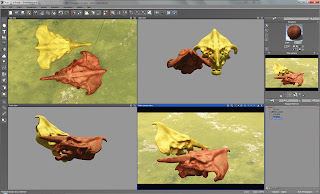A few days ago the count stood at 172 posts with over 225,000 page views, 1042 comments and 131 followers. This results in a mean number of page views per post of 1303. Most views last less than 15 seconds, so most viewers probably people leave the page after a quick glance, which is to be expected. Every now and again someone spends 45 or 90 minutes, though, and old posts keep on being read. I will show a number of lists to illustrate how viewers behave.
First, here are the 10 most-visited posts preceded by the number of page views:
- 6565 Swimming in Sand 1: the Sandworms of Dune / Feb 2011
- 3113 Warren Fahy's "Fragment" / Aug 2010
- 2814 A century of thoats / May 2012
- 2544 Avatar's 'Walking with hexapods' or 'Don't walk this way' / Feb 2010
- 2529 A future book on future evolution from France / Nov 2011
- 1451 "A Venusian Bestiary", in Which Greg Broadmore Ill... / Apr 2011
- 1408 Future evolution in Brussels / Feb 2009
- 1353 How many legs are best for megamonsters? / May 2011
- 1345 Ballooning animals and Newtonian fitness / Jul 2011
- 1312 How much more Speculative Biology is there? / Mar 2009
Here is a list of the most often used search terms resulting in people being referred to my blog:
- 1122 speculative biology
- 612 future evolution
- 566 dougal dixon greenworld
- 262 furahan biology
- 210 cladogram
- 204 henders island
- 200 planet furaha
- 197 bobby chiu
- 190 creature journal
- 190 furahan
There was also some bad news: my posts were copied verbatim on someone else's blog. I am at present busy with having these posts deleted through Google, citing a breach of copyright. That seems to be working well. I will not provide links to these blogs; these people are stealing page views from my blog, so I certainly will not direct attention to them. Away with parasites!
 |
| Click to enlarge; copyright Gert van Dijk |
That's enough about the blog. I have not done much with the main Furaha site, as I spent the little time I had on new digital paintings. The image above shows a study for one. I sculpted the head of an 'Ochreback Thresher' (Ira tarda) in Sculptris as a help with perspective. Its nasal horn can be used to ward off predators, but is also used in intraspecies conflicts. The horn fits under the opponent's parietal shield bosses, meaning the combatants obtain a lock on one another in which the one with the most stamina wins. The ridges on the side of the face are meant to protect the eyes (four, not well visible) from damage, but loss of one eye in dominant individuals is not uncommon. The painting will not show such a combat, by the way.
I will end with some good news and a question. I produced a 20-page sampler of The Book and have finally started sending it to publishers! I hope one will be interested, but do not dare expect much. After all, the book is as specialised as the blog, so the potential readership might be small. In my covering letter I wrote that it should appeal to people who like science fiction art and biology. If you have made it to the end of this post, you must be one of the interested people. Is that a good description of the possible readership? Is there a better one?
Epilogue, May 2, 2013
After the post was published I noticed a surge in page views. The source was easily identified: the Austrian newspaper 'Der Standard' had published an article about the post above, in which I had drawn attention to the fact that their earlier messages had resulted in clear spikes in the number of page views concerning the posts they had drawn attention to. Confused? You may be after this epilogue, because their article not only resulted in a spike in views of the post 'Five years on' (the one you are reading now), but also in the posts already in the top ten. The top ten for the last week was:
1. 267 Swimming in Sand....
2. 239 Five years on
3. 162 A Venusian bestiary...
4. 131 Avatar, or how...
5. 91 A century of thoats
See the list above for the links. To close the circle of references, you may visit the article at the site of 'Der Standard'. It is entitled 'What fascinates people about fictional life forms' (but in German, obviously). You will find it here.


